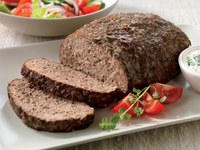Prairie Fare: Keep Family Meals a Tradition Post-pandemic
(Click an image below to view a high-resolution image that can be downloaded)
By Julie Garden-Robinson, Food and Nutrition Specialist
NDSU Extension
“Dinner’s ready!” my mom called out every night.
“No piano playing right now,” she added.
I grew up in a musical family. Inevitably, someone would stop on the way from the living room to the kitchen to play a tune on the piano.
I was as guilty as anyone about plopping down at the keyboard before dinner.
I have no idea why we did that. We certainly succeeded in irritating Mom, if that was our goal at the time.
During dinner time, the TV was turned off and the phone was not answered.
In fact, we had one TV with four channels and one phone. The distractions were minimal.
My kids have to be pried away from their technology for dinner, but we always have tried to maintain a tradition of eating together. We do not text at the table.
The COVID-19 pandemic has had one silver lining, maybe more. When schools and businesses were closed or had modified hours, more people ate meals together at home.
That is good news on several levels. Hundreds of studies have been published on the topic of family meal benefits.
Regular family meals can help improve students’ performance in their academic subjects. You need healthful food to fuel your brain.
Researchers have shown that children who eat with their families more often tend to earn more A’s and B’s than those who do not. They learn communication skills and build their vocabularies.
Children who eat with their families eat more fruits and vegetables, more calcium-rich foods and less high-fat, highly sweetened foods.
Children who eat with their families also are less likely to have eating disorders.
As my colleagues in family science can attest, family meals provide structure and stability. Children who eat more often with their families are less likely to engage in risky behavior such as drinking alcohol, smoking and drug abuse.
Eating together has benefits for adults, too. Adults are more likely to maintain their weight if they eat more often with their families.
If you want to reduce the stress level in your home, prioritize family meals, according to some recent research.
Eating at home can save money. Further, the ritual of having regular family meals may strengthen marriages as well as families.
If you run out of dinnertime topics, check out https://www.ag.ndsu.edu/familytable for a variety of conversation starters and resources about family meals. Subscribe to the monthly newsletter.
Family meals can be a time to learn about your own family history and flavorful recipes and also about recipes inspired by other cultures. Try time-saving equipment such as a pressure cooker.
The recipe is courtesy of BeefItsWhatsForDinner.com and the North Dakota Beef Commission and is certified by the American Heart Association. This Greek-inspired recipe can be made in a pressure cooker or in an oven.
Athenian Beef Meatloaf With Cucumber Yogurt Sauce
2 pounds ground beef (96% lean)
1 c. soft breadcrumbs
3/4 c. finely chopped onion
1/2 c. 1% low-fat milk
1 large egg
1 Tbsp. plus 1 1/2 tsp. dried Greek seasoning, divided (for meatloaf and topping)
1/2 tsp. salt
1 c. plain, low-fat Greek-style yogurt
1/2 c. diced cucumber
Pressure Cooker Directions (6 quart):
Combine ground beef, breadcrumbs, onion, milk, egg, 1 tablespoon dried Greek seasoning and salt in a large bowl, mixing lightly but thoroughly. Pour 3/4 cup water into pressure cooker; set pressure cooker rack in water. To make a foil sling, cut a 28-inch piece of heavy-duty aluminum foil (or layer two pieces of regular foil) and punch six to eight holes in it using a kitchen fork or small knife. Form beef mixture into an 8- by 4-inch loaf on the foil sling over the holes. Lower the meatloaf with the sling onto the pressure cooker rack. Close and lock pressure cooker lid. Use beef, stew or high pressure setting on pressure cooker; program 25 minutes on pressure cooker timer. Let the meatloaf stand in pressure cooker for 10 minutes after cooking is completed.
Meanwhile, combine yogurt, cucumber and remaining 1 1/2 teaspoons Greek seasoning in medium bowl. Season with salt as desired. Set aside. Use quick-release feature to release pressure from the pressure cooker; carefully remove lid. Using foil sling, transfer meatloaf to cutting board; remove foil and cut meatloaf into eight slices. Serve with cucumber-yogurt sauce. (This recipe variation was tested in an electric pressure cooker at high altitude. Cooking at an altitude of less than 3,000 feet may require slightly less cooking time. Refer to the manufacturer's instructions.)
Oven Directions:
Preheat oven to 350 F. Combine ground beef, breadcrumbs, onion, milk, egg, 1 tablespoon Greek seasoning and salt in large bowl, mixing lightly but thoroughly. Shape beef mixture into 10- by 4-inch loaf on rack in broiler pan. Bake in 350 F oven 1 1/4 to 1 1/2 hours, until instant-read thermometer inserted into center registers 160 F.
Makes eight servings. Each serving has 198 calories, 6 grams (g) fat, 28 g protein, 6 g carbohydrate, 0.4 g fiber and 247 milligrams sodium.
(Julie Garden-Robinson, Ph.D., R.D., L.R.D., is a North Dakota State University Extension food and nutrition specialist and professor in the Department of Health, Nutrition and Exercise Sciences. Follow her on Twitter @jgardenrobinson)
NDSU Agriculture Communication - May 6, 2021
Source: Julie Garden-Robinson, 701-231-7187, julie.garden-robinson@ndsu.edu
Editor: Ellen Crawford, 701-231-5391, ellen.crawford@ndsu.edu




